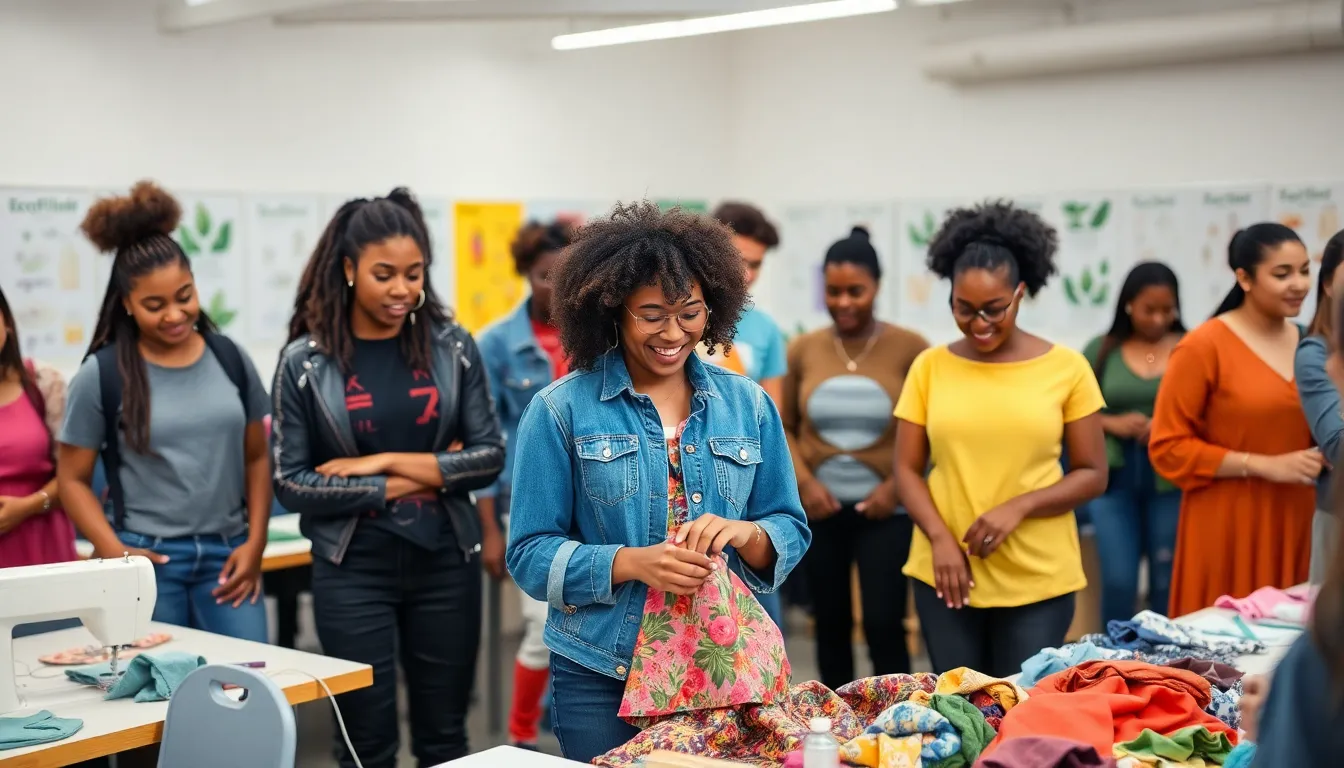In a world where fast fashion reigns and closet space is at a premium, sustainable fashion education is stepping up like a superhero in a thrift store cape. It’s not just about looking good; it’s about feeling good too—knowing that every outfit choice can contribute to a healthier planet. Imagine strutting your stuff while saving the Earth. Who knew saving the world could be so stylish?
Sustainable fashion education empowers individuals to make informed choices, transforming them from mere consumers into eco-warriors of the wardrobe. By learning the ins and outs of sustainable practices, they can navigate the fashion landscape with confidence and flair. So why not trade in those throwaway trends for timeless pieces that make a statement? It’s time to embrace a fashion revolution that’s as chic as it is conscientious.
Table of Contents
ToggleUnderstanding Sustainable Fashion Education
Sustainable fashion education promotes awareness about making conscious choices in clothing consumption. It focuses on combining environmental, social, and economic factors to create a responsible industry.
Definition and Importance
Sustainable fashion refers to clothing design, production, and consumption mindful of environmental impacts. This approach minimizes waste and pollution, prioritizing ethical labor practices. Understanding its significance leads to informed consumer choices, fostering eco-friendly brands. Knowledge of sustainable practices empowers individuals to challenge fast fashion, encouraging a shift towards longevity and quality. Education equips consumers with tools to advocate for more responsible practices across the fashion industry. Ultimately, awareness of sustainable fashion influences trends and promotes a circular economy.
Key Principles of Sustainability
Several key principles underpin sustainability in fashion. First, using sustainable materials, such as organic cotton or recycled fibers, reduces environmental harm. Second, ethical labor practices ensure fair wages and working conditions for all workers. Third, promoting longevity through timeless designs helps counteract disposability. Fourth, encouraging second-hand buying and clothing swaps fosters a culture of reuse. Lastly, embracing transparency allows brands to communicate their sustainability efforts, building consumer trust. Collectively, these principles create a holistic approach to sustainable fashion, benefiting the planet and its inhabitants.
Current Trends in Sustainable Fashion Education

Sustainable fashion education adapts to contemporary environmental challenges and consumer demands. Innovative teaching methods enhance engagement and promote critical thinking among students.
Innovative Teaching Approaches
Experiential learning programs immerse students in real-world sustainability practices. Case studies encourage analysis of successful eco-friendly brands and their practices. Project-based assignments motivate students to design sustainable collections. Workshops featuring industry experts provide insights into current trends and ethical practices. Collaborative projects foster teamwork while addressing sustainability challenges in fashion.
Integration of Technology
Technology transforms sustainable fashion education, making it more accessible and interactive. Online platforms facilitate global discussions about sustainability issues. Virtual reality experiences offer immersive learning by simulating the impacts of fashion on the environment. Data analytics tools track sustainability metrics, helping students understand measurement. Mobile applications guide consumers toward responsible fashion choices. By leveraging technology, educational institutions expand their reach and foster a deeper understanding of sustainable practices.
Challenges in Sustainable Fashion Education
Sustainable fashion education faces various significant challenges. These obstacles hinder the full integration of sustainability principles into educational frameworks.
Curriculum Gaps
Educational programs often lack comprehensive curricula that address sustainable fashion. Many institutions fall short in covering critical topics such as ethical sourcing, environmental impacts, and the lifecycle of materials. Students miss out on essential knowledge that prepares them for the industry. Inconsistent standards further complicate matters, leading to varied interpretations of sustainability across programs. As a result, graduates may enter the workforce without the necessary skills to advocate for environmentally conscious practices. Integrating sustainability into all aspects of fashion education would foster a more informed and responsible generation of designers, consumers, and industry leaders.
Industry Collaboration Issues
Collaboration between educational institutions and the fashion industry often proves challenging. Limited partnerships reduce opportunities for students to gain hands-on experience with sustainable practices. Employers frequently seek candidates who are intimately familiar with real-world applications, making industry ties crucial. Additionally, inconsistent communication between educators and industry leaders amplifies the disconnect. Establishing strong relationships can provide valuable insights into current trends and practices, enhancing educational content. Strengthening these connections can lead to a more robust educational framework that aligns with the evolving demands of sustainable fashion.
Successful Sustainable Fashion Education Programs
Sustainable fashion education programs showcase effective models that inspire change in the industry. Highlighting successful case studies can motivate institutions to adopt similar practices.
Case Studies
Leading programs, such as the Fashion Institute of Technology’s Sustainable Fashion degree, provide immersive learning experiences. Another example is the University of Cambridge’s Master of Studies in Sustainability Leadership, which focuses on responsible design and production. Programs like these emphasize partnerships with eco-friendly brands, giving students real-world exposure. Schools often integrate sustainability into existing courses, reinforcing critical concepts through adoptable frameworks. Faculty and industry experts share firsthand insights, bridging the gap between theory and practice. Such initiatives exemplify how educational institutions can cultivate a new generation committed to sustainable fashion.
Impact on Students and Communities
Students involved in sustainable fashion education often emerge as proactive advocates for eco-conscious practices. Many graduates inspire their communities through sustainable initiatives, such as local clothing swaps and educational workshops. Programs frequently engage with surrounding neighborhoods, promoting awareness around responsible fashion consumption. Collaboration with local businesses enhances hands-on learning while fostering support for sustainable brands. Awareness and activism increase as students influence peers, fostering a culture of sustainability. This ripple effect showcases the transformative power of education in promoting environmental stewardship within broader communities.
Future Directions for Sustainable Fashion Education
Sustainable fashion education’s evolution hinges on emerging trends and actionable recommendations for educators. This approach ensures that future generations understand sustainable practices thoroughly.
Emerging Trends
Adaptive learning experiences embrace immersive technologies like virtual reality and augmented reality, enabling students to visualize environmental impacts effectively. Gamified learning methods engage students, making education interactive and memorable. Integrating artificial intelligence in curriculum design personalizes learning, addressing the unique needs of each student. Collaboration with industry leaders brings real-world expertise into classrooms, enhancing the relevance of programs. Online courses expand accessibility, allowing individuals globally to participate in sustainable fashion education. Legislative shifts toward eco-friendly practices create urgency, spurring educational institutions to update programs in alignment with sustainability goals.
Recommendations for Educators
Incorporating hands-on projects can enhance experiential learning, allowing students to apply theoretical knowledge in practical settings. Regularly updating curricula to reflect current industry practices ensures that students remain informed about sustainable trends. Forming partnerships with sustainable brands offers students networking opportunities and real-world insights. Hosting workshops featuring industry experts cultivates an environment of shared knowledge and innovation. Encouraging interdisciplinary collaboration provides a broader perspective on sustainability’s role across various fields. Implementing community-focused initiatives fosters social responsibility and enables students to practice advocacy within their communities.
Sustainable fashion education serves as a crucial catalyst for change in the industry. By empowering individuals with knowledge about eco-friendly practices and ethical consumption, it fosters a generation of informed consumers and advocates. The integration of innovative teaching methods and collaboration with industry leaders enhances the learning experience, making sustainability accessible and engaging.
As students immerse themselves in sustainable practices, they not only develop skills but also inspire their communities to embrace responsible fashion choices. The ongoing evolution of sustainable fashion education promises to address current challenges and adapt to future demands, ensuring that the movement toward a more sustainable industry continues to grow. Through education, the fashion landscape can transform into one that values both style and sustainability.


